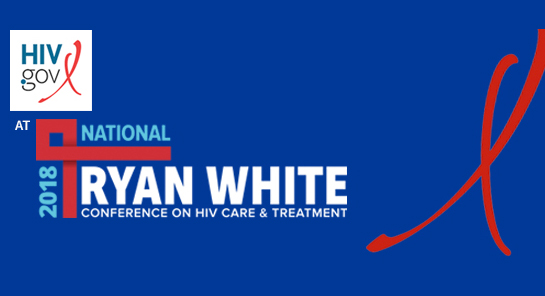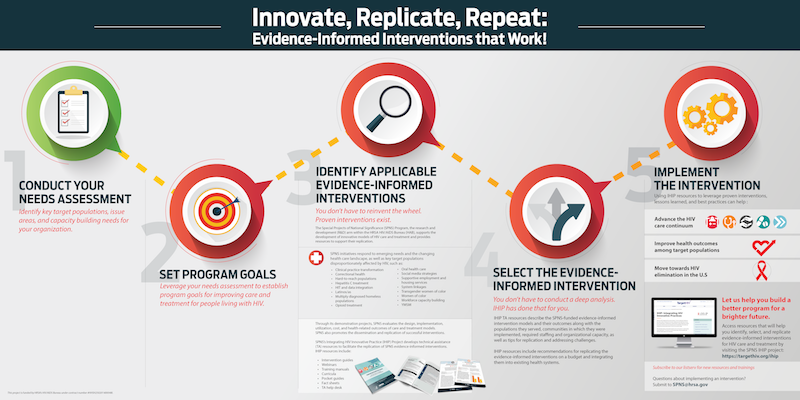Ryan White 2018: Evidence-Informed Interventions
Topics
Cross-posted from TargetHIVExit Disclaimer

The word "evidence" appears 47 times in various Ryan White Conference session titles; "evidence-informed," 14 times. Identifying and disseminating innovative, effective HIV interventions is an ongoing focus of the RWHAP under the SPNS program and a series of new HRSA projects, like E2i and IHIP, highlighted below. (For the full list, see the sidebar.) One goal of this work is to establish an online database of program implementation resources on the TargetHIV website.
The HIV.gov Social Media Lab is in the Exhibit Hall and is open Thursday 10 am-4 pm. Drop in for free, one-on-one technical assistance and get answers to your questions about how best to use social media.
E2i: A National Implementation
A Wednesday session presented the following insights from the E2i: Using Evidence-Informed Interventions to Improve Health Outcomes among People Living with HIVExit Disclaimer. (See National Implementation of Evidence-Informed Interventions for PLWH Across 26 Sites, Wednesday 1:30-3:00pm on the conference agendaExit Disclaimer.)

Core Elements
Jessica Xavier, former HRSA staff member, explained that a number of E2i interventions emerged out of previous Special Projects of National Significance (SPNS) interventions, National Institute of Mental Health (NIMH), and other sources. Among the 26 projects was Transgender Women Engagement and Entry to Care Project (TWEET), which links participants to HIV primary care and support services and provides five education sessions to prepare participants to be peer leaders. Another project, non-SPNS, was Healthy Divas (a gender affirmation model comprised of 6 sessions).
Several models target African American MSM and are based on Popular Opinion Leader (POL) and teach-back methods. They include Peer Motivational Interviewing (PEERS MI), which focuses on medication adherence in brief single sessions along with self management; Project CONNECT (focuses on linking the newly diagnosed to care with a linkage coordinator, who works to build rapport, take a psychosocial history, prepare the individual for their first visit, among other goals); and TXTXT (a text messaging intervention that is a two-way messaging intervention to support adherence. Texts include reminders, confirmation of having taken medications, and encouragement).
Other projects focus on trauma-informed care (resilience enhancement and strength-based approach and another that focuses on cognitive processing therapy to deal with Post Traumatic Stress Disorder, PTSD, considered a gold standard approach); coping skills approach covering 25 topics in group and individual settings. Buprenorphine treatment (to help interrupt the negative impact of opioid abuse on HIV medication adherence); a team-based approach to care management with a focus on behavioral health; and SBIRT, an evidence-informed intervention to screen for substance abuse and provide brief counseling in order to integrate behavioral health into HIV care.
Organizational Assessments
This phase served to identify where agencies need capacity support to deliver interventions. An assessment survey was conducted across the 26 sites. Some have been in business for over 100 years and some are new at two years. Number of patients also varied widely. The survey also shows variations in how many had written policies and procedures on group/learning (e.g., hiring, training) and supervision.
The survey also assessed the environment for adoption of interventions in terms of readiness (e.g., acceptability, feasibility, long term viability, cost). A scale of readiness also determined that most if not all sites were fairly ready to implement.
Strengths identified from the assessment: leaders were supportive and organizational goals lined up with the intervention. One area for growth was to bring some leaders on board.
Adaptation Strategies
The 5-step adaptation and rapid implementation process was outlined, from assessment to piloting, implementation and points in between. A method for rapid implementation over a 12-month period was developed that involved creation of an intervention repository and eventual selection and training of the 26 sites. Intervention selection was driven by such criteria currently being a RWHAP agency, not currently implementing the intervention, and other criteria. Selected sites received a multi-day training, while capacity building needs and opportunities were identified.
Site Experiences
A handful of the 26 E2i sites outlined their experiences to date:
- Formation of site-specific groups to implement the work and inclusion of consumers and make room for other staff departments interested in the intervention.
- Variable levels of consumer engagement, some high, some not so much.
- Development of a training curriculum and data collection plan.
- Increased staff capacity in terms of teach-back skills.
- Adaptations of interventions with clients, like the sequencing of patient assessments; changes in tracking tools; and inclusion of new patient populations.
- Daily review of patients scheduled for a given day and added attention to those not virally suppressed.
- Tracking and modification of patient encounters, like the provision of support counseling as needed.
Poster: Identifying and Implementing
The below Innovate, Replicate, Repeat-Evidence-Informed Interventions that Work! posterExit Disclaimer [PDF, 565KB] from IHIP, Integrating HIV Innovative PracticesExit Disclaimer, outlines the process for identifying and implementing an evidence-informed intervention and ways that IHIP resources can help agencies develop proven interventions for HIV care and treatment. Learn more about the SPNS IHIPExit Disclaimer.
